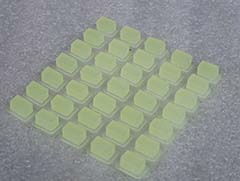TPU antimicrobial performance
 TPU antimicrobial growth performance is closely related
to the soft segment structure. The polyester soft segment is not antimicrobial,
while the polyether soft segment has strong resistance. Here we discuss the
comparison of TPU anti-microbial growth with rubber and plastic, and the
influence of microorganisms on mechanical properties.
TPU antimicrobial growth performance is closely related
to the soft segment structure. The polyester soft segment is not antimicrobial,
while the polyether soft segment has strong resistance. Here we discuss the
comparison of TPU anti-microbial growth with rubber and plastic, and the
influence of microorganisms on mechanical properties.
(1) Comparison of TPU with rubber and plastic. The
microorganisms tested were penicillin, aspergillus, aureobasidin, mixed spores
and other microorganisms. The results show that PET-TPU, chloroprene rubber,
and nitrile rubber have no microbial growth; natural rubber has, but not
serious; PVC is the most serious, and the growth of the above-mentioned
microorganisms is at least 30%, and more than 60% or even 100%. It can be seen
that the antimicrobial performance of PET-TPU is quite good.
(2) The influence of microorganisms on mechanical
properties Estane TPU
cable sheath has been buried in the ground for 3 years to examine its ability
to resist microorganisms and fungi. The locations are in Ohio, Arizona, and
Florida in the United States. The data fully shows that in the 3 states buried
in the soil for 3 years, although the conditions are different, the PET-TPU has
mechanical properties such as hardness, 100% tensile stress and 300% tensile
stress, tensile strength and elongation at break. There is no decline, and even
an increase. In addition to the loss of less than 20% of mechanical properties
in Ohio, the loss of tensile strength and elongation at break of PES-TPU was
69% and 76%, respectively, in Arizona. The losses were 74% and 93%,
respectively. It can be seen that the ability of PET-TPU to preserve the
initial mechanical properties in a microbial environment is much better than
that of PES-TPU.
The long-term TPU antimicrobial test is expensive and
time-consuming. A quick method is to determine its saponification value. The
saponification value refers to the amount of KOH (mg) consumed by the
saponification of 1g TPU. The saponification value of TPU that meets the
standard must be less than 200, PET-TPU is generally between 30-50, and PES-TPU
is between 200-300.










